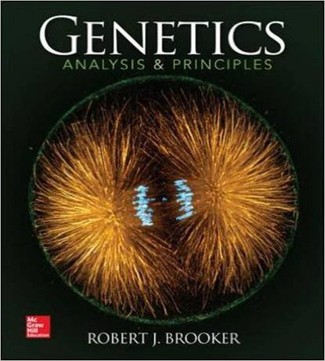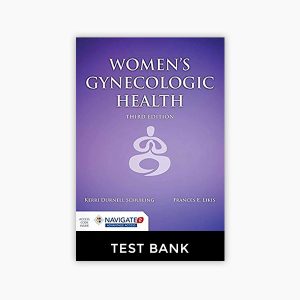Genetics Analysis and Principles 5th Edition Brooker Test Bank

Product details:
- ISBN-10 : 1259343049
- ISBN-13 : 978-1259343049
- Author: Robert Brooker
Genetics: Analysis and Principles is a one-semester, introductory genetics textbook that takes an experimental approach to understanding genetics. By weaving one or two experiments into the narrative of each chapter, students can simultaneously explore the scientific method and understand the genetic principles that have been learned from these experiments. The pedagogy of Genetics: Analysis and Principles has been designed to foster student learning. Instead of being a collection of facts and figures, this text is intended to be an engaging and motivating textbook in which formative assessment allows students to move ahead and learn the material in a productive way.
Description:
Chapter 03
Chromosome Transmission During Cell Division and Sexual Reproduction
Check All That Apply Questions
- In prokaryotic cells
__X__ genetic information is contained within a nucleoid region.
__X__ genetic material is organized as a single circular chromosome.
_____ membrane bound organelles are found in the cytoplasm.
__X__ a cell wall surrounds the plasma membrane.
Bloom’s Level: 2. Understand
Learning Outcome: 03.01.02 Outline key differences between prokaryotic and eukaryotic cells.
Section: 03.01
Topic: General Features Of Chromosomes
Multiple Choice Questions
- Organelles are __________.
A.structures that contain the genetic material.
B. membrane-bound compartments of eukaryotic cells.
C. the region that contains the DNA in prokaryotic cells.
D. the outer, rigid covering of a prokaryotic cell.
Accessibility: Keyboard Navigation
Bloom’s Level: 1. Remember
Learning Outcome: 03.01.02 Outline key differences between prokaryotic and eukaryotic cells.
Section: 03.01
Topic: General Features Of Chromosomes
- A karyotype is a(n) __________.
A.organelle of eukaryotic cells.
B. stage of prophase I in meiosis.
C. division of the cytoplasmic material following mitosis.
D. organized representation of the chromosomes within a cell.
E. None of the answers are correct
Accessibility: Keyboard Navigation
Bloom’s Level: 1. Remember
Learning Outcome: 03.01.03 Describe the procedure for making a karyotype.
Section: 03.01
Topic: General Features Of Chromosomes
- You are performing a karyotype for the first time and you forget to add the colchicine. How do you predict this will affect your karyotype?
A. No affect – your karyotype will look normal.
B. You will be unable to see any chromosomes under the microscope.
C. You will only be able to see one of each chromosome.
D. The chromosomes in some cells will look normal (highly compacted) but in other cells distinct chromosomes will be hard to identify.
Accessibility: Keyboard Navigation
Bloom’s Level: 3. Apply
Learning Outcome: 03.01.03 Describe the procedure for making a karyotype.
Section: 03.01
Topic: General Features Of Chromosomes
- During sexual reproduction, each parent contributes one set of chromosomes. Members of a pair of chromosomes (one from each parent) are called __________.
A.karyotypes
B. sister chromatids
C. homologs
D. sex chromosomes
Accessibility: Keyboard Navigation
Bloom’s Level: 1. Remember
Learning Outcome: 03.01.04 Compare and contrast the similarities and differences between homologous chromosomes.
Section: 03.01
Topic: General Features Of Chromosomes
- Which of the following would contain genetic material that is 100% identical?
A.Homologous chromosomes
B. Sister chromatids
C. X and Y chromosomes
D. All of the answers are identical
Accessibility: Keyboard Navigation
Bloom’s Level: 2. Understand
General LO: Understand processes and molecular mechanisms involved in mitosis and meiosis.
Section: 03.02
Topic: Cell Division
- You are studying a diploid organism that has 14 sets of chromosomes. How many chromatids would this cell have in G2 phase?
A. 7
B. 14
C. 28
D. 56
Accessibility: Keyboard Navigation
Bloom’s Level: 4. Analyze
Learning Outcome: 03.02.02 List and outline the phases of the eukaryotic cell cycle.
Section: 03.02
Topic: Cell Division
- You are studying a diploid organism that has 14 sets of chromosomes. How many chromosomes will a gamete from this organism have?
A. 7
B. 14
C. 28
D. 56
Accessibility: Keyboard Navigation
Bloom’s Level: 4. Analyze
Learning Outcome: 03.04.01 List and describe the phases of meiosis.
Section: 03.02
Topic: Cell Division
- You are studying a diploid organism that has 14 sets of chromosomes. How many chromatids will a cell from this organism have in metaphase of meiosis II?
A. 7
B. 14
C. 28
D. 56
Accessibility: Keyboard Navigation
Bloom’s Level: 4. Analyze
Learning Outcome: 03.04.01 List and describe the phases of meiosis.
Section: 03.02
Topic: Cell Division
- The location of a gene on a chromosome is called its _____________.
A.karyotype
B. allele
C. locus
D. homolog
Accessibility: Keyboard Navigation
Bloom’s Level: 1. Remember
Learning Outcome: 03.01.04 Compare and contrast the similarities and differences between homologous chromosomes.
Section: 03.01
Topic: General Features Of Chromosomes
- Cell division in prokaryotic cells is called ________, while in eukaryotic cells it is called ________.
A.binary fission ; binary fission
B. binary fission ; mitosis
C. meiosis ; mitosis
D. mitosis ; binary fission
Accessibility: Keyboard Navigation
Bloom’s Level: 1. Remember
Learning Outcome: 03.02.01 Describe the process of binary fission in bacteria.
Section: 03.02
Topic: Cell Division
- During this phase of the cell cycle, the sister chromatids are formed:
A.G1 phase
B. G2 phase
C. S phase
D. Prophase
E. Cytokinesis
Accessibility: Keyboard Navigation
Bloom’s Level: 1. Remember
Learning Outcome: 03.02.02 List and outline the phases of the eukaryotic cell cycle.
Section: 03.02
Topic: Cell Division
- During this phase of the cell cycle chromosomes start to condense:
A.Metaphase
B. Prometaphase
C. Telophase
D. Anaphase
E. Prophase
Accessibility: Keyboard Navigation
Bloom’s Level: 1. Remember
Learning Outcome: 03.03.02 List and describe the phases of mitosis.
Section: 03.03
Topic: Mitosis And Cytokinesis
- During this phase of the cell cycle sister chromatids separate and head towards opposite poles of the cell:
A.Metaphase
B. Prometaphase
C. Telophase
D. Anaphase
E. Prophase
Accessibility: Keyboard Navigation
Bloom’s Level: 1. Remember
Learning Outcome: 03.03.02 List and describe the phases of mitosis.
Section: 03.03
Topic: Mitosis And Cytokinesis
People also search:
genetics analysis and principles
introduction to genetics analysis
genetics analysis and principles 6th edition free
the principles of genetics lab answers
introduction to genetic analysis pdf free download





